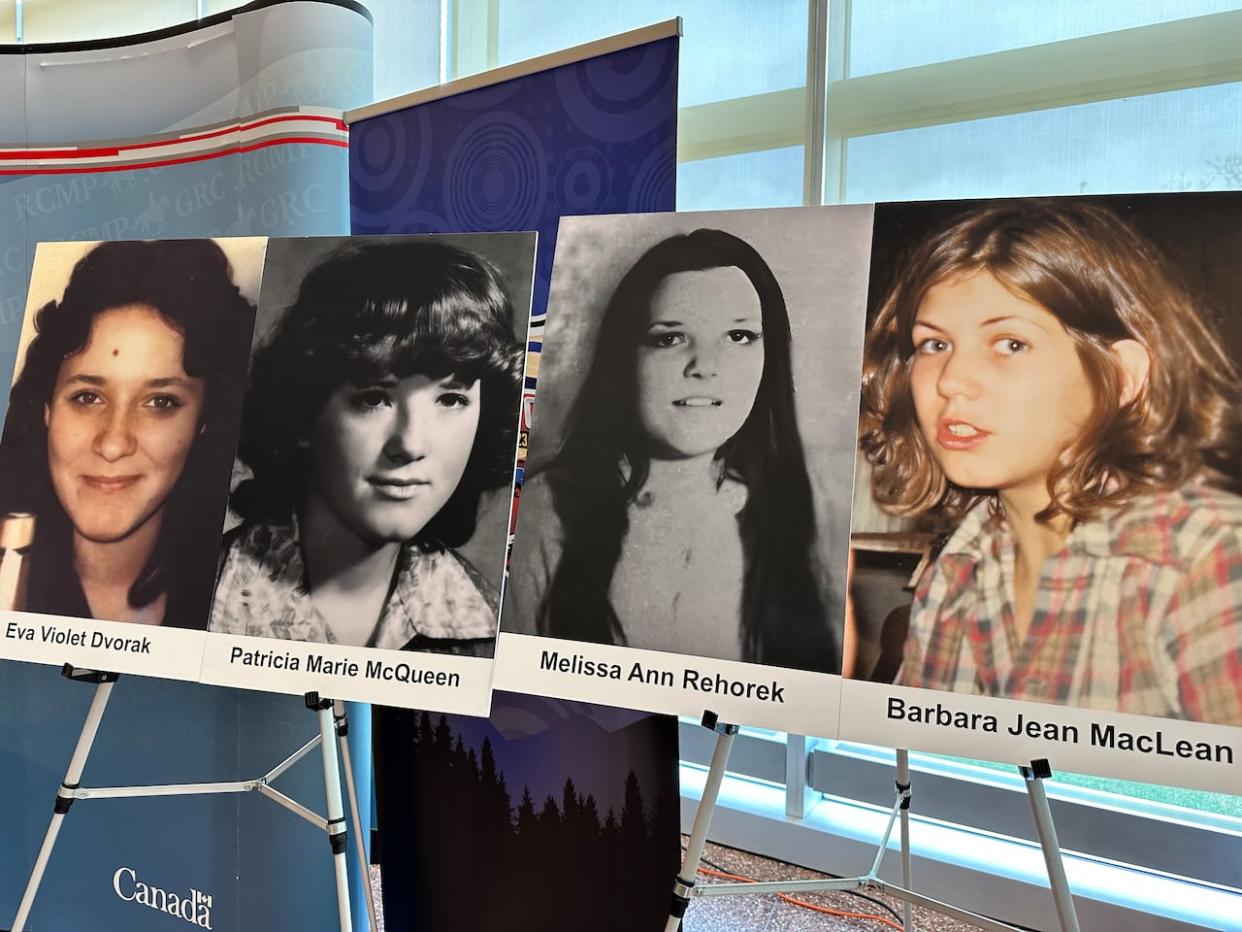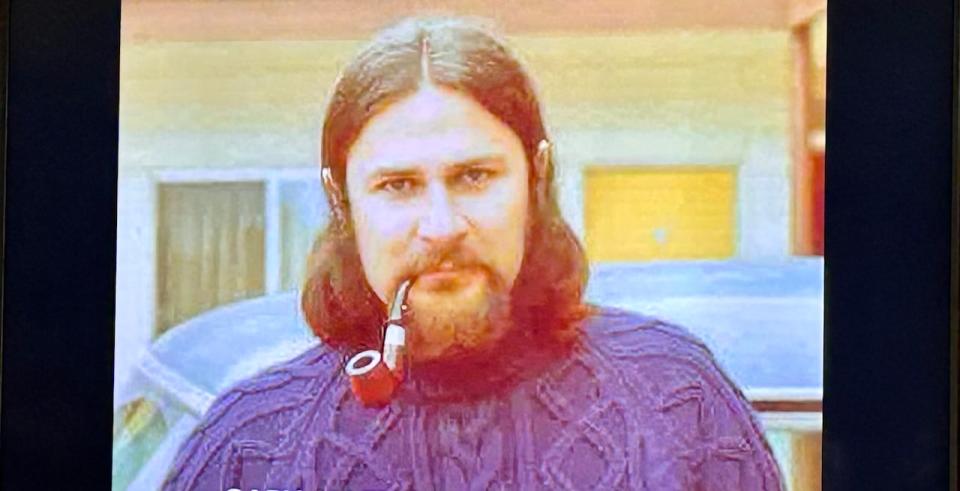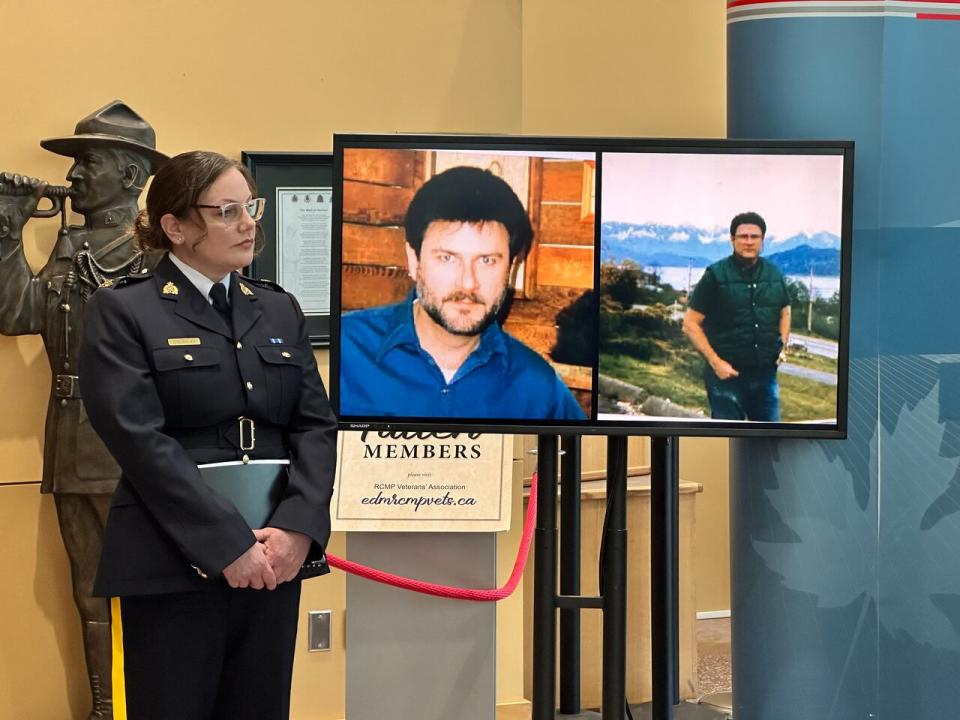Alberta RCMP link four Calgary murders in 1970s to American serial killer

Alberta RCMP have solved four historical homicides dating to the 1970s, linking them to a single man — a serial killer and repeat sexual offender who police believe likely committed violent sexual crimes until his death in an Idaho prison in 2011.
Gary Allen Srery was responsible for the deaths of four young victims in Calgary in the 1970s, RCMP said at a news conference Friday.
Srery was a predator who stalked his victims from behind the wheel, targeting young women and girls before discarding their bodies on the roadside.
RCMP said he was a charismatic killer who would often approach his victims with kindness before turning to violence.
Police say DNA evidence confirms that he killed Eva Dvorak and Patricia McQueen, both 14. He also killed Melissa Rehorek, 20, and Barbara MacLean, 19.
Srery died in 2011 in a state prison in Idaho while serving a life sentence for rape. Having no family to claim his body, he was buried behind the institution where he died.
RCMP believe there may be other victims, living or dead, who have yet to be identified.
Srery was a transient who lived between Canada and the United States, often changing his appearance and relying on aliases to disguise his identity.
He had an extensive criminal record dating back to 1966 for violent sexual crimes against women.
During his time in Canada he lived across Alberta and British Columbia and police believe he may have committed other unsolved crimes in the communities he called home.
Srery — born in 1942 in Oak Park, Ill. — was identified through the use of DNA and criminal databases that helped trace his family tree.
RCMP said his name had never surfaced during the course of decades of investigation, and that only DNA evidence and an ancestry investigation linked him to the killings.

Police say Gary Allen Srery, who died in 2011, was responsible for the deaths of four young victims in Calgary in the 1970s. (Alberta RCMP)
Police believe there may be other victims, both living and dead, who have yet to be identified.
"For over 40 years, investigators did not give up in their pursuit to identify those responsible for these murders," Supt. David Hall, officer in charge of the Alberta RCMP's serious crimes branch, said in a statement.
"Identifying the perpetrator does not bring Eva, Patsy, Melissa or Barbara back. It is our hope, however, that the families are finally able to have some answers as to what happened to their loved ones all of those years ago."
During a technical briefing with reporters, RCMP detailed each of the four cases and their similarities.
Each of the victims vanished from Calgary. Their bodies were found on the outskirts of the city with no attempts to conceal their remains.
All were young and vulnerable. All were taken while walking late at night. Their bodies were found fully clothed. Each had been sexually assaulted and died from asphyxiation. Their killer left traces of DNA evidence.
Eva and Patricia
Of the four cases now solved, Eva and Patricia — known as Patsy — were the first to be killed.
On Feb. 12, 1976, the girls, students at Ian Bazalgette Junior High School in Calgary, left class and stayed together, visiting the homes of friends. One missing person's report was filed.
The girls were last seen on Feb. 15, around midnight, walking near 9th Avenue and 12th Street S.E. in Calgary, heading toward downtown.
Their bodies were found the following morning under the Happy Valley underpass, west of Calgary.
The girls were lying together, fully clothed, on the road. There was no obvious sign of death.
Witnesses were interviewed. Investigators examined tire impressions found at the scene and did extensive toxicology tests that ultimately ruled out drugs as a factor in their deaths.
The manner of death was ruled to be asphyxia but the circumstances of the girls' deaths remained a mystery for decades.
Then, in 2022, RCMP received a tip about the case that would act as a catalyst for a re-examination of the DNA evidence, and ultimately the identification of Srery as the killer.
Melissa Rehorek
In the fall of 1976, Srery killed Melissa Rehorek on the western outskirts of Calgary.
Rehorek, 20, who had moved to Calgary from Windsor, was living at a downtown YMCA and working as a housekeeper at a nearby hotel.
She loved spending time outdoors and told her friends she planned to hitchhike out of the city and west down the highway to spend the weekend in the mountains.
A Calgary transit driver told investigators that he may have dropped her off in the Bowness area near Highway 1 on Sept. 15.
Her body was found the next morning in a ditch off a remote gravel road, 22 kilometres west of Calgary.
There was evidence of a struggle. An autopsy determined she had died of asphyxia by strangulation. She had also suffered a blow to the head.
In her hand, investigators found she was grasping long black hairs that were not hers.
Hair analysis was done but a suspect was not identified.
RCMP said many persons of interest were investigated in her killing, including known offenders in the area, but no arrests were made.
Police said the DNA evidence recovered from Rehorek's body was analyzed in the 1990s when the technology first became available. But it would be years before a national database was developed.
Barbara MacLean
Barbara MacLean, 19, had just moved to Calgary from Nova Scotia and worked at a bank.
The night before she died, she was with a group of friends at a cabaret at the Highlander bar.
MacLean was last seen walking alone from the hotel in the early hours of Feb. 26, 1977. Her body was discovered by a dog walker in the area of 6th Street and 80th Avenue NE, Calgary, about six hours later.
The trauma to her body showed she had fought back against her killer, RCMP said. Blood was found on her left hand, and foreign hairs were found on her body, which had numerous marks and bruises. She had been strangled.
Hundreds of taxi drivers were interviewed, as investigators at the time believed she had taken a cab home.
By 1977 alone, more than 600 men had provided hair samples to police for comparison. Many persons of interest were named but ultimately eliminated and the case grew cold.
A DNA link
The killer was ultimately identified through the mapping of his family tree.
Evidence seized from all four victims was submitted to the RCMP's National Forensic Lab Services for testing, but at the time, the technology to develop a DNA profile did not exist.
In 2003, with the advancement of enhanced DNA analysis, police were able to confirm the same suspect was linked to both the Rehorek and MacLean murders.
At that time, the suspect's DNA was compared against the National DNA Databank, but a match wasn't found. The killer, then nameless, was designated as "individual A."
The profile went without a hit for over 20 years. Then in 2021, the RCMP and Calgary police formed a partnership to use Investigative Genetic Genealogy (IGG) in an attempt to identify the suspect. The database relies on genetic samples to identify potential relatives of unidentified suspects.
RCMP investigators re-examined the exhibits that they had seized more than 45 years ago. They worked with the RCMP lab and Parabon NanoLabs to develop a single profile that was then uploaded to GEDMatch and FamilyTreeDNA.
Genealogists working in partnership with the RCMP began building a family tree based on the profile and identified Srery as a match.
In September 2023, Idaho state police confirmed Srery's DNA matched the unknown male profile from the Alberta killings.
The resulting investigation, which took RCMP investigators throughout Alberta, B.C. and several U.S. states confirmed he was the killer.
Police learned Srery had entered Canada illegally in the early 1970s and was later deported to the U.S.
A violent drifter
The eldest of three children, he moved with his family from Illinois to California in the mid 1950s where he completed high school.
He had multiple children with his wife of nine years but later divorced. Former partners described him to police as charming.
Srery was a violent drifter, in and out of prison, rarely working, moving frequently, and relying on fake names.
He often worked under the table as a cook.
In Canada, he often lived on welfare or worked manual labour jobs. Police are investigating a tip that he may have served a stint as a ferry worker in B.C.

RCMP Insp. Breanne Brown with images of Srery at Friday's news conference. (Trevor Wilson/CBC)
Former partners described him to police as charming. Surviving victims of his crimes described him as violent and threatening.
His history of offences dates back to the 1960s in Los Angeles, when he was charged with petty theft. He was arrested in the same city in 1965 for a violent sexual assault and convicted of rape by force, sodomy and kidnapping.
He spent a total of seven years in prison throughout his life, including stints in San Quentin.
RCMP say he crossed illegally into Canada sometime in 1974 after posting bail for a rape charge in California. He surfaced in Calgary in 1976 and lived in the city for at least two years.
Srery lived in Alberta and British Columbia from the mid to late 1970s up until 2003 when he was deported
Investigators said they are concerned about the years that passed when he had little contact with RCMP.
He had no meaningful contact with police until he was arrested, charged and convicted for an assault in New Westminister, B.C., in 1998.
RCMP are urging victims, or anyone with information on the missing pieces of the killer's timeline in Canada, to come forward.

